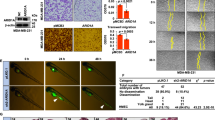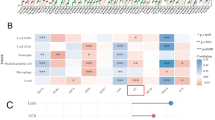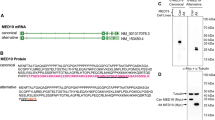Abstract
The IG20 gene is overexpressed in human tumors and cancer cell lines, and encodes at least four splice variants (SVs) namely, IG20pa, MADD, IG20-SV2 and DENN-SV. Earlier, gain-of-function studies showed that IG20-SVs can exhibit diverse functions and play a critical role in cell proliferation and apoptosis. Expression of exogenous IG20pa or DENN-SV rendered cells either susceptible or resistant to induced apoptosis, respectively, whereas MADD and IG20-SV2 had no apparent effect. In order to understand the contrasting effects of the IG20-SVs in a physiologically more relevant system, we expressed exon-specific small hairpin RNAs (shRNAs) to selectively knockdown specific IG20-SVs. Consistent with an earlier study, knockdown of all IG20-SVs resulted in spontaneous apoptosis of HeLa and PA-1 cells. In addition, we unambiguously demonstrated that knockdown of MADD can render cells susceptible to spontaneous apoptosis but had no discernible effect on cell proliferation, colony size or cell cycle progression. Moreover, expression of MADD alone, and not DENN-SV, in the absence of endogenous IG20-SVs was sufficient to prevent spontaneous apoptosis. Our results show the utility of shRNAs for selective knockdown of particular IG20-SVs and their potential therapeutic value in cancer. Further, they demonstrate that MADD alone is sufficient and necessary for cancer cell survival.
This is a preview of subscription content, access via your institution
Access options
Subscribe to this journal
Receive 50 print issues and online access
$259.00 per year
only $5.18 per issue
Buy this article
- Purchase on SpringerLink
- Instant access to full article PDF
Prices may be subject to local taxes which are calculated during checkout









Similar content being viewed by others
References
Al-Zoubi AM, Efimova EV, Kaithamana S, Martinez O, El-Idrissi ME, Dogan RE et al. (2001). J Biol Chem 276: 47202–47211.
Andreadis A, Gallego ME, Nadal-Ginard B . (1987). Annu Rev Cell Biol 3: 207–242.
Brinkman BM, Telliez JB, Schievella AR, Lin LL, Goldfeld AE . (1999). J Biol Chem 274: 30882–30886.
Brown TL, Howe PH . (1998). Curr Biol 8: R191.
Brummelkamp TR, Bernards R, Agami R . (2002). Science 296: 550–553.
Chow VT, Lee SS . (1996). DNA Seq 6: 263–273.
Chow VT, Lim KM, Lim D . (1998). Genome 41: 543–552.
Cullen BR . (2004). Virus Res 102: 3–9.
Cullen BR . (2005). Gene Therapy 6: 503–508.
Cunningham SJ . (1996). Cloning and characterization of a novel cDNA isolated from human beta cells.PhD thesis. The University of Texas Medical Branch, Galveston, TX.
Del Villar K, Miller CA . (2004). Proc Natl Acad Sci USA 101: 4210–4215.
Efimova EV, Al-Zoubi AM, Martinez O, Kaithamana S, Lu SF, Arima T et al. (2004). Oncogene 23: 1076–1087.
Efimova EV, Martinez O, Lokshin A, Arima T, Prabhakar BS . (2003). Cancer Res 63: 8768–8776.
Elbashir SM, Harborth J, Lendeckel W, Yalcin A, Weber K, Tuschl T . (2001a). Nature 411: 494–498.
Elbashir SM, Lendeckel W, Tuschl T . (2001b). Genes Dev 15: 188–200.
Goto Y, De Silva MG, Toscani A, Prabhakar BS, Notkins AL, Lan MS . (1992). J Biol Chem 267: 15252–15257.
Hall J . (2004). Nat Rev Genet 5: 552–557.
Hutvágner G, Zamore PD . (2002). Science 297: 2056–2060.
Iwasaki K, Toyonaga R . (2000). EMBO J 19: 4806–4816.
Johnstone RW, Ruefli AA, Lowe SW . (2002). Cell 108: 153–164.
Kerr JF, Wyllie AH, Currie AR . (1972). Br J Cancer 26: 239–257.
Lee MT, Coburn GA, McClure MO, Cullen BR . (2003). J Virol 77: 11964–11972.
Levivier E, Goud B, Souchet M, Calmels TP, Mornon JP, Callebaut I . (2001). Biochem Biophys Res Commun 287: 688–695.
Lim KM, Chow VT . (2002). Mol Carcinog 35: 110–126.
Lim KM, Yeo WS, Chow VT . (2004). Int J Cancer 109: 24–37.
McManus MT, Sharp PA . (2002). Nat Rev Genet 3: 737–747.
Murakami-Mori K, Mori S, Bonavida B, Nakamura S . (1999). J Immunol 162: 3672–3679.
Ramaswamy M, Efimova EV, Martinez O, Mulherkar NU, Singh SP, Prabhakar BS . (2004). Oncogene 23: 6083–6094.
Reynolds A, Leake D, Boese Q, Scaringe S, Marshall WS, Khvorova A . (2004). Nat Biotechnol 22: 326–330.
Schievella AR, Chen JH, Graham JR, Lin LL . (1997). J Biol Chem 272: 12069–12075.
Tanaka M, Miyoshi J, Ishizaki H, Togawa A, Ohnishi K, Endo K et al. (2001). Mol Biol Cell 12: 1421–1430.
Telliez JB, Bean KM, Lin LL . (2000). Biochem Biophys Acta 1478: 280–288.
Wada M, Nakanishi H, Satoh A, Hirano H, Obaishi H, Matsuura Y et al. (1997). J Biol Chem 272: 3875–3878.
Yamaguchi K, Tanaka M, Mizoguchi A, Hirata Y, Ishizaki H, Kaneko K et al. (2002). Proc Natl Acad Sci USA 99: 14536–14541.
Zhang Y, Zhou L, Miller CA . (1998). Proc Natl Acad Sci USA 95: 2586–2591.
Acknowledgements
We thank Dr Reuven Agami for pSUPER, Dr BR Cullen and Dr TJ Hope for lentivirus system, Dr Chenthamarakshan Vasu for help with CFSE staining, Dr Balaji Manicassamy for help with mutant-construct generation and Dr Prasad Kanteti for his valuable critique. This work was in part supported by grant #5R01CA107506 from National Institutes of Health, Bethesda, MD.
Author information
Authors and Affiliations
Corresponding author
Rights and permissions
About this article
Cite this article
Mulherkar, N., Ramaswamy, M., Mordi, D. et al. MADD/DENN splice variant of the IG20 gene is necessary and sufficient for cancer cell survival. Oncogene 25, 6252–6261 (2006). https://doi.org/10.1038/sj.onc.1209650
Received:
Revised:
Accepted:
Published:
Issue date:
DOI: https://doi.org/10.1038/sj.onc.1209650
Keywords
This article is cited by
-
Homozygous variant in MADD, encoding a Rab guanine nucleotide exchange factor, results in pleiotropic effects and a multisystemic disorder
European Journal of Human Genetics (2021)
-
Loss of MADD expression inhibits cellular growth and metastasis in anaplastic thyroid cancer
Cell Death & Disease (2019)
-
DENN/MADD/IG20 Alternative Splicing Changes and Cell Death in Alzheimer’s Disease
Journal of Molecular Neuroscience (2012)
-
Splicing factor hnRNPH drives an oncogenic splicing switch in gliomas
The EMBO Journal (2011)
-
What is the role of alternate splicing in antigen presentation by major histocompatibility complex class I molecules?
Immunologic Research (2010)



